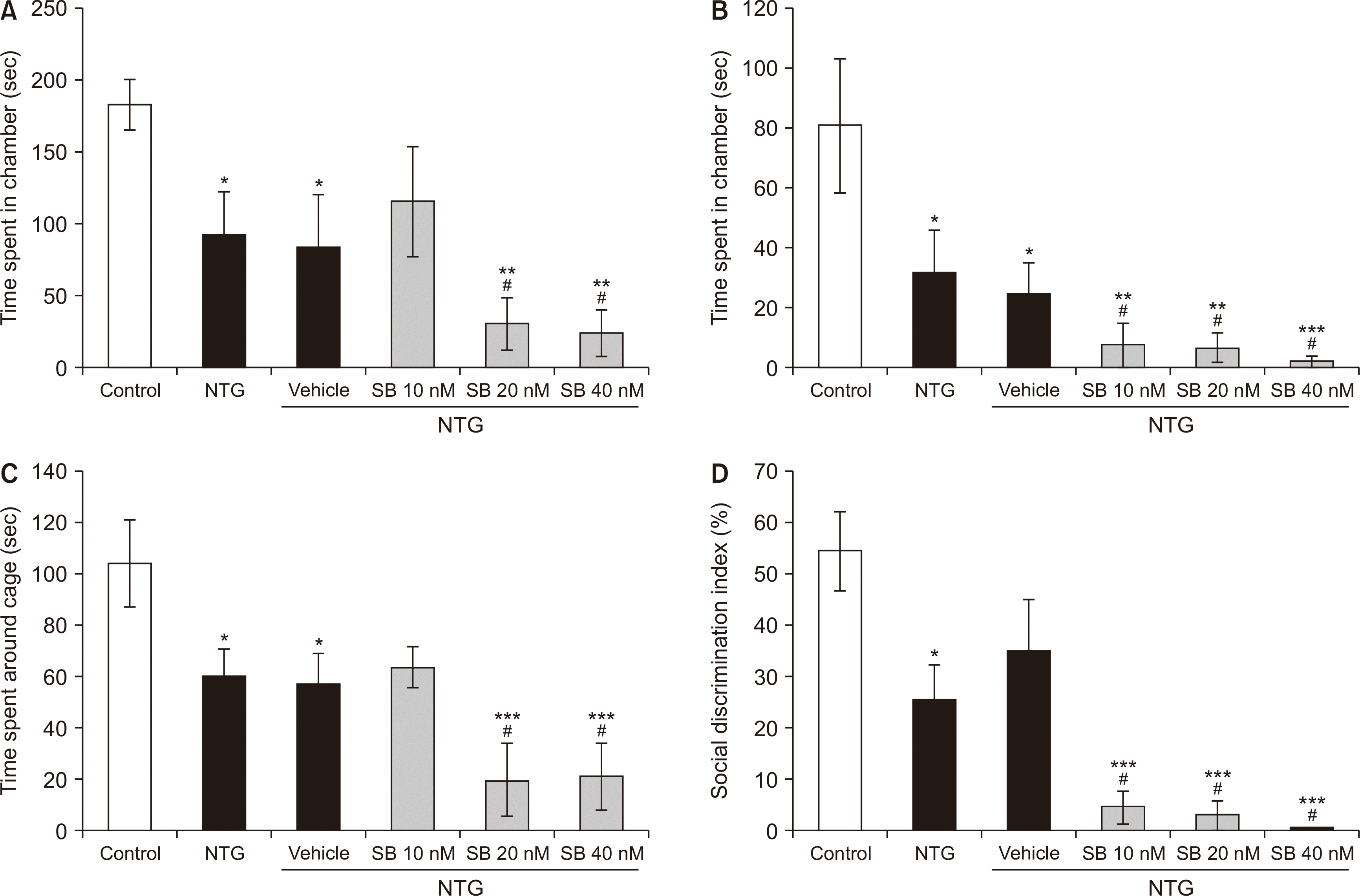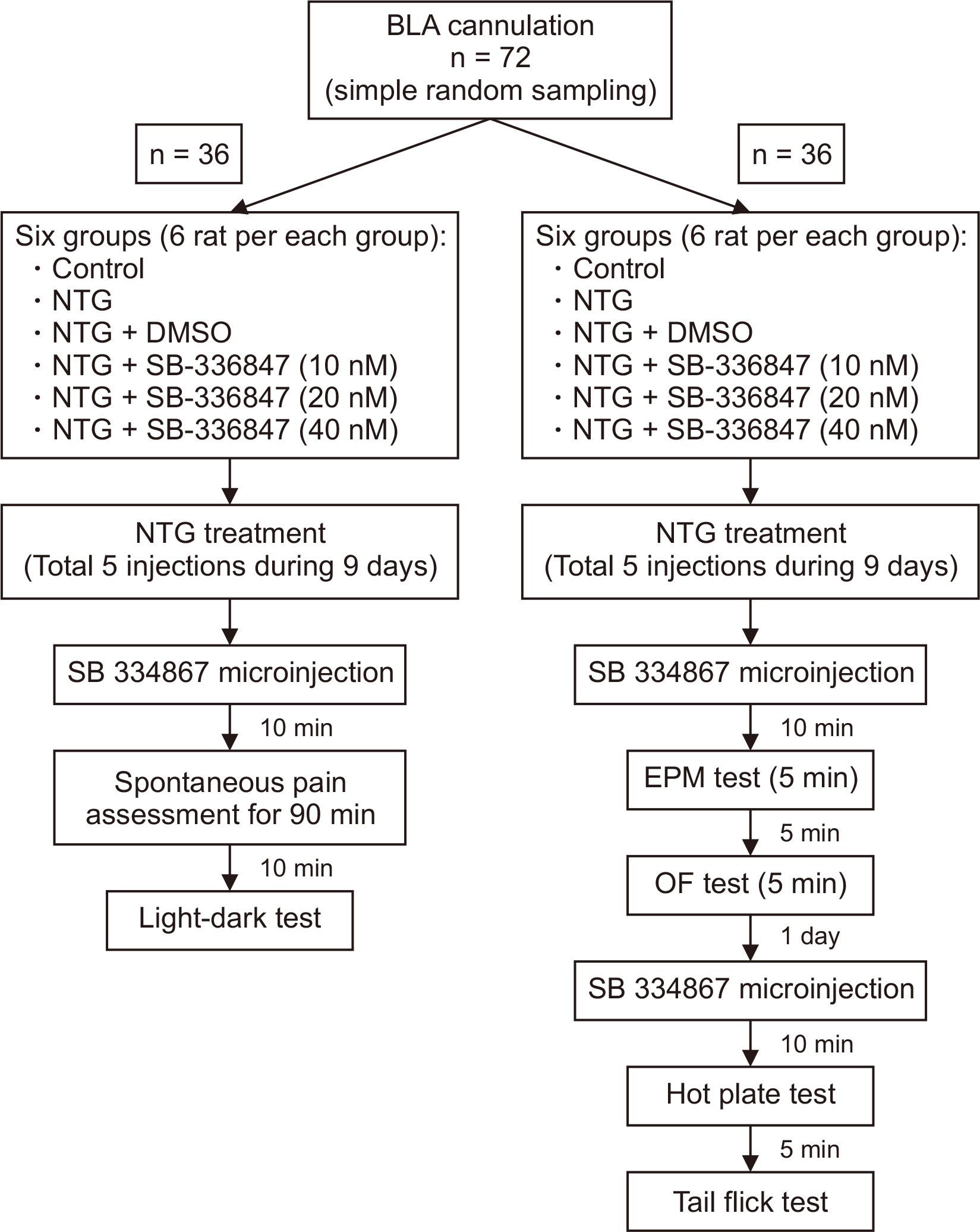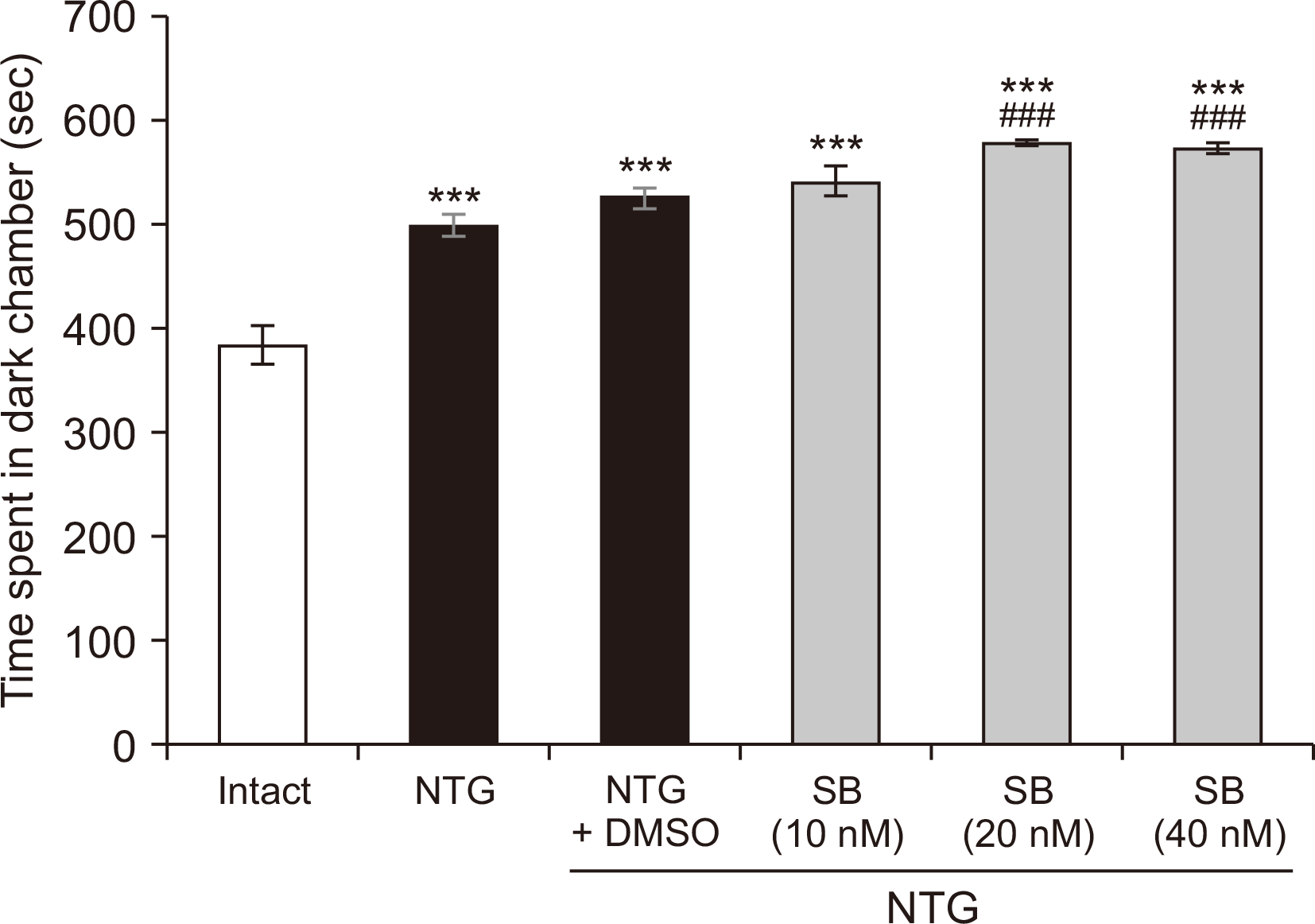1. Dodick DW. 2018; A phase-by-phase review of migraine pathophysiology. Headache. 58 Suppl 1:4–16. DOI:
10.1111/head.13300. PMID:
29697154.

2. Balaban CD, Jacob RG, Furman JM. 2011; Neurologic bases for comorbidity of balance disorders, anxiety disorders and migraine: neurotherapeutic implications. Expert Rev Neurother. 11:379–94. DOI:
10.1586/ern.11.19. PMID:
21375443. PMCID:
PMC3107725.

4. Hadjikhani N, Ward N, Boshyan J, Napadow V, Maeda Y, Truini A, et al. 2013; The missing link: enhanced functional connectivity between amygdala and visceroceptive cortex in migraine. Cephalalgia. 33:1264–8. DOI:
10.1177/0333102413490344. PMID:
23720503. PMCID:
PMC3797870.

5. Chen Z, Chen X, Liu M, Dong Z, Ma L, Yu S. 2017; Altered functional connectivity of amygdala underlying the neuromechanism of migraine pathogenesis. J Headache Pain. 18:7. DOI:
10.1186/s10194-017-0722-5. PMID:
28116559. PMCID:
PMC5256627.

7. de Tommaso M, Libro G, Guido M, Difruscolo O, Losito L, Sardaro M, et al. 2004; Nitroglycerin induces migraine headache and central sensitization phenomena in patients with migraine without aura: a study of laser evoked potentials. Neurosci Lett. 363:272–5. DOI:
10.1016/j.neulet.2004.04.029. PMID:
15182958.

8. Kilduff TS, Peyron C. 2000; The hypocretin/orexin ligand-receptor system: implications for sleep and sleep disorders. Trends Neurosci. 23:359–65. DOI:
10.1016/S0166-2236(00)01594-0. PMID:
10906799.

9. Flores Á, Herry C, Maldonado R, Berrendero F. 2017; Facilitation of contextual fear extinction by orexin-1 receptor antagonism is associated with the activation of specific amygdala cell subpopulations. Int J Neuropsychopharmacol. 20:654–9. DOI:
10.1093/ijnp/pyx029. PMID:
28453642. PMCID:
PMC5570099.

10. Kim TK, Han PL. 2016; Functional connectivity of basolateral amygdala neurons carrying orexin receptors and melanin-concentrating hormone receptors in regulating sociability and mood-related behaviors. Exp Neurobiol. 25:307–17. DOI:
10.5607/en.2016.25.6.307. PMID:
28035181. PMCID:
PMC5195816.

11. Holland PR, Akerman S, Goadsby PJ. 2006; Modulation of nociceptive dural input to the trigeminal nucleus caudalis via activation of the orexin 1 receptor in the rat. Eur J Neurosci. 24:2825–33. DOI:
10.1111/j.1460-9568.2006.05168.x. PMID:
17156207.

13. Kooshki R, Abbasnejad M, Esmaeili-Mahani S, Raoof M, Sheibani V. 2020; Activation orexin 1 receptors in the ventrolateral periaqueductal gray matter attenuate nitroglycerin-induced migraine attacks and calcitonin gene related peptide up-regulation in trigeminal nucleus caudalis of rats. Neuropharmacology. 178:107981. DOI:
10.1016/j.neuropharm.2020.107981. PMID:
32745488.

14. Raoof M, Shakoori A, Kooshki R, Abbasnejad M, Amanpour S. 2017; The effects of regular exercise on capsaicin-induced pulpal pain and pain-induced changes in passive avoidance learning and memory in rats. Korean J Pain. 30:258–64. DOI:
10.3344/kjp.2017.30.4.258. PMID:
29123620. PMCID:
PMC5665737.

15. Yao G, Huang Q, Wang M, Yang CL, Liu CF, Yu TM. 2017; Behavioral study of a rat model of migraine induced by CGRP. Neurosci Lett. 651:134–9. DOI:
10.1016/j.neulet.2017.04.059. PMID:
28479104.

17. Farkas S, Bölcskei K, Markovics A, Varga A, Kis-Varga Á, Kormos V, et al. 2016; Utility of different outcome measures for the nitroglycerin model of migraine in mice. J Pharmacol Toxicol Methods. 77:33–44. DOI:
10.1016/j.vascn.2015.09.006. PMID:
26456070.

18. Bates EA, Nikai T, Brennan KC, Fu YH, Charles AC, Basbaum AI, et al. 2010; Sumatriptan alleviates nitroglycerin-induced mechanical and thermal allodynia in mice. Cephalalgia. 30:170–8. DOI:
10.1111/j.1468-2982.2009.01864.x. PMID:
19489890. PMCID:
PMC4854191.

19. Greco R, Demartini C, Zanaboni AM, Tassorelli C. 2018; Chronic and intermittent administration of systemic nitroglycerin in the rat induces an increase in the gene expression of CGRP in central areas: potential contribution to pain processing. J Headache Pain. 19:51. DOI:
10.1186/s10194-018-0879-6. PMID:
30003352. PMCID:
PMC6043463.

20. Li Y, Zhang Q, Qi D, Zhang L, Yi L, Li Q, et al. 2016; Valproate ameliorates nitroglycerin-induced migraine in trigeminal nucleus caudalis in rats through inhibition of NF-κB. J Headache Pain. 17:49. DOI:
10.1186/s10194-016-0631-z. PMID:
27150105. PMCID:
PMC4859223.

23. Bigal ME, Ashina S, Burstein R, Reed ML, Buse D, Serrano D, et al. 2008; Prevalence and characteristics of allodynia in headache sufferers: a population study. Neurology. 70:1525–33. DOI:
10.1212/01.wnl.0000310645.31020.b1. PMID:
18427069. PMCID:
PMC2664547.

24. Schwedt TJ, Krauss MJ, Frey K, Gereau RW 4th. 2011; Episodic and chronic migraineurs are hypersensitive to thermal stimuli between migraine attacks. Cephalalgia. 31:6–12. DOI:
10.1177/0333102410365108. PMID:
20974609. PMCID:
PMC3541827.

25. Gottschalk MG, Richter J, Ziegler C, Schiele MA, Mann J, Geiger MJ, et al. 2019; Orexin in the anxiety spectrum: association of a HCRTR1 polymorphism with panic disorder/agoraphobia, CBT treatment response and fear-related intermediate phenotypes. Transl Psychiatry. 9:75. DOI:
10.1038/s41398-019-0415-8. PMID:
30718541. PMCID:
PMC6361931.

27. Johnson PL, Truitt W, Fitz SD, Minick PE, Dietrich A, Sanghani S, et al. 2010; A key role for orexin in panic anxiety. Nat Med. 16:111–5. DOI:
10.1038/nm.2075. PMID:
20037593. PMCID:
PMC2832844.

28. Flores Á, Valls-Comamala V, Costa G, Saravia R, Maldonado R, Berrendero F. 2014; The hypocretin/orexin system mediates the extinction of fear memories. Neuropsychopharmacology. 39:2732–41. DOI:
10.1038/npp.2014.146. PMID:
24930888. PMCID:
PMC4200503.

29. Wang C, Wang Q, Ji B, Pan Y, Xu C, Cheng B, et al. 2018; The orexin/receptor system: molecular mechanism and therapeutic potential for neurological diseases. Front Mol Neurosci. 11:220. DOI:
10.3389/fnmol.2018.00220. PMID:
30002617. PMCID:
PMC6031739.

30. Schafe GE, Atkins CM, Swank MW, Bauer EP, Sweatt JD, LeDoux JE. 2000; Activation of ERK/MAP kinase in the amygdala is required for memory consolidation of pavlovian fear conditioning. J Neurosci. 20:8177–87. DOI:
10.1523/JNEUROSCI.20-21-08177.2000. PMID:
11050141. PMCID:
PMC6772720.

31. Keil MF, Briassoulis G, Stratakis CA. 2016; The role of protein kinase A in anxiety behaviors. Neuroendocrinology. 103:625–39. DOI:
10.1159/000444880. PMID:
26939049.

32. Yang L, Shi LJ, Yu J, Zhang YQ. 2016; Activation of protein kinase A in the amygdala modulates anxiety-like behaviors in social defeat exposed mice. Mol Brain. 9:3. DOI:
10.1186/s13041-015-0181-3. PMID:
26747511. PMCID:
PMC4706664.

33. Di Benedetto B, Kallnik M, Weisenhorn DM, Falls WA, Wurst W, Hölter SM. 2009; Activation of ERK/MAPK in the lateral amygdala of the mouse is required for acquisition of a fear-potentiated startle response. Neuropsychopharmacology. 34:356–66. DOI:
10.1038/npp.2008.57. PMID:
18432190.

34. Maldonado NM, Espejo PJ, Martijena ID, Molina VA. 2014; Activation of ERK2 in basolateral amygdala underlies the promoting influence of stress on fear memory and anxiety: influence of midazolam pretreatment. Eur Neuropsychopharmacol. 24:262–70. DOI:
10.1016/j.euroneuro.2013.10.005. PMID:
24182621.

35. Abbas MG, Shoji H, Soya S, Hondo M, Miyakawa T, Sakurai T. 2015; Comprehensive behavioral analysis of male Ox1r (-/-) mice showed implication of orexin receptor-1 in mood, anxiety, and social behavior. Front Behav Neurosci. 9:324. DOI:
10.3389/fnbeh.2015.00324. PMID:
26696848. PMCID:
PMC4674555.
36. Yang L, Zou B, Xiong X, Pascual C, Xie J, Malik A, et al. 2013; Hypocretin/orexin neurons contribute to hippocampus-dependent social memory and synaptic plasticity in mice. J Neurosci. 33:5275–84. DOI:
10.1523/JNEUROSCI.3200-12.2013. PMID:
23516292. PMCID:
PMC3640412.

37. Blouin AM, Fried I, Wilson CL, Staba RJ, Behnke EJ, Lam HA, et al. 2013; Human hypocretin and melanin-concentrating hormone levels are linked to emotion and social interaction. Nat Commun. 4:1547. DOI:
10.1038/ncomms2461. PMID:
23462990. PMCID:
PMC3595130.

38. Eacret D, Grafe LA, Dobkin J, Gotter AL, Renger JJ, Winrow CJ, et al. 2019; Orexin signaling during social defeat stress influences subsequent social interaction behaviour and recognition memory. Behav Brain Res. 356:444–52. DOI:
10.1016/j.bbr.2018.05.032. PMID:
29902478.

39. Wellman LL, Forcelli PA, Aguilar BL, Malkova L. 2016; Bidirectional control of social behavior by activity within basolateral and central amygdala of primates. J Neurosci. 36:8746–56. DOI:
10.1523/JNEUROSCI.0333-16.2016. PMID:
27535919. PMCID:
PMC4987442.

40. Flanigan ME, Aleyasin H, Li L, Burnett CJ, Chan KL, LeClair KB, et al. 2020; Orexin signaling in GABAergic lateral habenula neurons modulates aggressive behavior. Nat Neurosci. 23:638–50. DOI:
10.1038/s41593-020-0617-7. PMID:
32284606. PMCID:
PMC7195257.

41. Ward RJ, Pediani JD, Milligan G. 2011; Heteromultimerization of cannabinoid CB(1) receptor and orexin OX(1) receptor generates a unique complex in which both protomers are regulated by orexin A. J Biol Chem. 286:37414–28. DOI:
10.1074/jbc.M111.287649. PMID:
21908614. PMCID:
PMC3199489.

42. Aracri P, Banfi D, Pasini ME, Amadeo A, Becchetti A. 2015; Hypocretin (orexin) regulates glutamate input to fast-spiking interneurons in layer V of the Fr2 region of the murine prefrontal cortex. Cereb Cortex. 25:1330–47. DOI:
10.1093/cercor/bht326. PMID:
24297328. PMCID:
PMC4397574.

43. Li Z, Wang J, Chen L, Zhang M, Wan Y. 2013; Basolateral amygdala lesion inhibits the development of pain chronicity in neuropathic pain rats. PLoS One. 8:e70921. DOI:
10.1371/journal.pone.0070921. PMID:
23940666. PMCID:
PMC3733720.

45. Kosarmadar N, Ghasemzadeh Z, Rezayof A. 2015; Inhibition of microglia in the basolateral amygdala enhanced morphine-induced antinociception: possible role of GABAA receptors. Eur J Pharmacol. 765:157–63. DOI:
10.1016/j.ejphar.2015.08.027. PMID:
26297974.

46. Pavlovic JM, Akcali D, Bolay H, Bernstein C, Maleki N. 2017; Sex-related influences in migraine. J Neurosci Res. 95:587–93. DOI:
10.1002/jnr.23903. PMID:
27870430.
47. Delaruelle Z, Ivanova TA, Khan S, Negro A, Ornello R, Raffaelli B, et al. 2018; Male and female sex hormones in primary headaches. J Headache Pain. 19:117. DOI:
10.1186/s10194-018-0922-7. PMID:
30497379. PMCID:
PMC6755575.

48. Maleki N. Maassen van den Brink A, MacGregor EA, editors. 2019. Gender differences in imaging studies in migraine. Gender and migraine. Springer;Cham: p. 101–11.








 PDF
PDF Citation
Citation Print
Print







 XML Download
XML Download